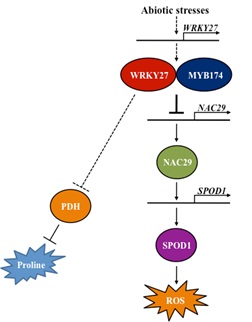The Plant Journal:中国科学院遗传与发育生物学研究所陈受宜和张劲
大豆是重要的经济作物,是人类食用油脂和蛋白及动物饲料的重要来源。其在响应非生物胁迫的分子调控机制方面的研究仍然存在较大空白。
中国科学院遗传与发育生物学研究所基因组生物学研究中心/植物基因组学国家重点实验室陈受宜研究组和张劲松研究组在前期的研究中鉴定出一系列能够响应逆境胁迫的转录因子。本研究利用转化大豆毛状根的实验体系,对其中筛选到的WRKY27蛋白进行了更深入研究。表型分析结果表明,WRKY27能够受多种非生物胁迫的诱导并能显著提高大豆对干旱和盐胁迫的适应性。进一步研究表明,通过结合大豆胁迫应答的负调控因子NAC29启动子区的W-box,WRKY27蛋白能够抑制NAC29的负调控作用。同时,本研究通过一系列的生化实验分析,鉴定出WRKY27的互作蛋白MYB174,并且证明MYB174能够通过抑制NAC29的表达从而提高大豆的耐逆性。ChIP-PCR等结果进一步表明,WRKY27与MYB174 在植物体内能够通过相互作用并结合NAC29启动子区相邻的顺势作用元件(cis-elements),从而精确调控大豆对干旱和盐等非生物胁迫的响应(图1)。
本研究通过研究两种不同转录因子之间的相互作用,对大豆等模式作物在逆境胁迫的分子机制方面提供了一个新的研究角度。通过改造和利用WRKY27,将可能有利于环境胁迫下模式作物的改良。该研究于2015年5月20日在线发表于The Plant Journal,DOI: 10.1111/tpj.12879。王昉博士和陈昊伟博士是该篇论文的共同第一作者。相关研究项目受973,国家自然基金和转基因专项等资助。

图1. WRKY27调控大豆耐盐抗旱的信号通路
WRKY27基因的表达受干旱和盐胁迫的诱导。通过结合负调控因子NAC29启动子区相邻的核心元件,WRKY27与MYB174相互作用,共同抑制NAC29的基因表达,从而调控SPOD1的表达及活性氧(ROS)的产生。同时,WRKY27可能通过抑制PDH的的表达,从而提高脯氨酸的产量。
原文链接:
GmWRKY27 interacts with GmMYB174 to reduce expression of GmNAC29 for stress tolerance in soybean plants
原文摘要:
Soybean (Glycine max) is an important crop for oil and protein resources worldwide. The molecular mechanism of abiotic stress response in soybean is largely unclear. We previously identified multiple stress-responsive WRKY genes from soybean. Here, we further characterized the roles of one of these genes, GmWRKY27,in abiotic stress tolerance using transgenic hairy root assay. GmWRKY27 expression was improved by various abiotic stresses. Overexpression and RNAi analysis demonstrate that GmWRKY27 improved salt and drought tolerance in transgenic soybean hairy roots. Measurement of physiological parameters including reactive oxygen species and proline contents also supported this conclusion. GmWRKY27 inhibits expression of a downstream gene GmNAC29 by binding to the W-boxes in its promoter region. The GmNAC29 is a negative effector of stress tolerance as revealed from the performance of transgenic hairy roots under stress. GmWRKY27 interacts with GmMYB174, which also suppresses GmNAC29 expression and enhances drought stress tolerance. The GmWRKY27 and GmMYB174 may have evolved to adapt to each other for binding to the neighbouring cis-elements in GmNAC29 promoter to co-reduce the promoter activity and gene expression. Our study discloses a valuable mechanism in soybean for stress response by two associated transcription factors. Manipulation of these genes should facilitate stress tolerance in soybean and other crops.
DOI: 10.1111/tpj.12879
作者:生物帮

